Sensory Processing Disorder vs. Autism

Introduction to Sensory Processing Differences
Sensory processing differences are prevalent in a variety of neurodevelopmental conditions, notably in Sensory Processing Disorder (SPD) and Autism Spectrum Disorder (ASD). While these conditions often overlap, particularly regarding sensory sensitivities, they are distinct in their origins, manifestations, and treatment approaches. This article explores the core distinctions and similarities between SPD and autism, delving into their neurological underpinnings, diagnostic criteria, behavioral traits, and recent advances in research and intervention.
Defining Conditions and Their Diagnostic Landscape
Overview of SPD and autism
Sensory Processing Disorder (SPD) and autism spectrum disorder (ASD) often share overlapping features, particularly involving sensory sensitivities. SPD is characterized by difficulties in how the brain perceives, modulates, and interprets sensory information from the environment, leading to hypersensitivity or hyposensitivity to stimuli such as light, sound, touch, taste, and internal sensations like proprioception and vestibular input. These sensory difficulties can result in challenges with daily routines, emotional regulation, and motor functions.
Autism, on the other hand, is a broad neurodevelopmental condition distinguished by persistent challenges in social communication, social interaction, and the presence of repetitive behaviors or restricted interests. While sensory issues are common in autism, they are only one part of the larger constellation of symptoms. Autism involves difficulties with understanding social cues, establishing relationships, and engaging in typical developmental milestones, with symptoms generally evident by age 2.
Diagnostic criteria and methods
Diagnosing autism relies on behavioral observation, developmental history, and parental input, as there is no specific medical test for it. The DSM-5 outlines criteria that focus on social communication deficits and restricted, repetitive behaviors. Healthcare professionals analyze language, social interaction, behavioral patterns, and developmental progress.
In contrast, SPD is not officially recognized in the DSM-5 or DSM-5-TR as a standalone diagnosis. Instead, therapists and clinicians observe behavioral patterns through assessments conducted by occupational therapists who use tools like sensory profile questionnaires and functional observations. Diagnosis hinges on identifying how sensory processing difficulties interfere with daily life activities.
Early intervention is essential for both conditions. Identifying sensory sensitivities can help guide tailored therapies, as occupational therapy with sensory integration strategies is effective in managing SPD symptoms. For autism, interdisciplinary approaches may include behavioral therapies, speech-language therapy, and possibly medication to address specific symptoms.
Prevalence and comorbidity rates
Studies reveal that over 80% of children with autism also experience sensory processing issues, and approximately 90% of individuals on the spectrum have sensory differences. This high co-occurrence indicates significant overlap. Conversely, most children with SPD—estimated at around 16% of children—do not meet the diagnostic criteria for autism, although they may exhibit behaviors similar to those seen in ASD.
Research also shows that brain imaging techniques, such as MRI and diffusion tensor imaging, highlight differences in brain connectivity between individuals with ASD and those with SPD. For example, children with autism tend to have disrupted connectivity in social-emotional processing pathways, while children with SPD often show impaired sensory region connectivity that is less centered on social cognition.
Despite overlapping features, the distinction between SPD and autism remains essential for effective management and intervention. Understanding their prevalence and neurobiological differences allows clinicians and parents to make informed decisions and advocate for appropriate support.
Types and Manifestations of SPD
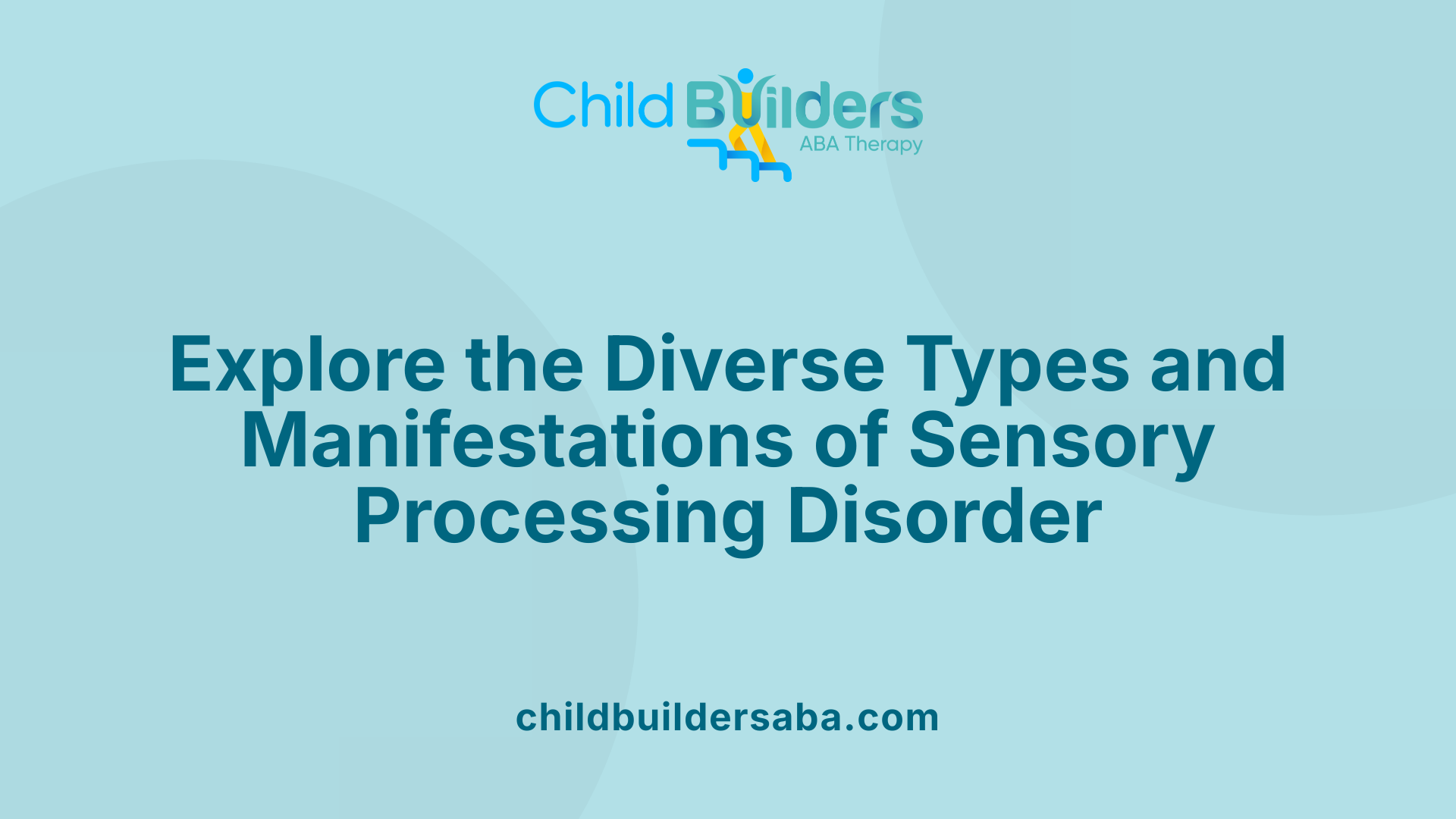
What are the different types of sensory processing disorder?
Sensory Processing Disorder (SPD) is not a single condition but encompasses various subtypes, classified by how individuals respond to sensory stimuli. These subtypes include:
Sensory Over-Responsivity (SOR): Individuals are overly sensitive to sensory input, often reacting strongly or negatively to sights, sounds, textures, or smells. They may find certain stimuli overwhelming, leading to discomfort or distress.
Sensory Under-Responsivity (SUR): This subtype is characterized by diminished responsiveness to sensory stimuli. Children may seem dull or unresponsive, not noticing or reacting to tactile, auditory, or visual inputs as expected.
Sensory Craving (SC): Those with sensory craving seek out intense or excessive sensory input. They might engage in behaviors like spinning, jumping, or chewing, sometimes to an extreme degree.
Sensory Discrimination Disorder: This involves difficulty distinguishing between different sensory inputs, such as confusing textures, sounds, or visual cues, which can affect daily tasks like dressing or sorting objects.
Additional classifications include postural disorder and dyspraxia, both affecting motor skills and body awareness. These subtypes can manifest in behaviors such as discomfort with certain clothing tags, clumsiness, or challenges in balancing and coordination.
While SPD itself is not officially listed in medical diagnostic manuals, recognizing these patterns helps guide effective management. Occupational therapists often tailor sensory integration therapy to address each subtype, aiming to reduce discomfort, improve coordination, and enhance daily functioning.
How does sensory processing disorder differ from high-functioning autism?
SPD and high-functioning autism (a form of Autism Spectrum Disorder, ASD) share several sensory-related features, making differentiation important. SPD involves difficulty in detecting, regulating, and interpreting sensory information, which results in behavioral reactions such as hypersensitivity or hyposensitivity. However, SPD does not necessarily include the social and communicative challenges intrinsic to autism.
Children with autism often display persistent difficulties in social interaction, understanding social cues, communication, and exhibit repetitive behaviors. These core features set autism apart from SPD, although many children with ASD also experience sensory processing issues—studies show that up to 90% or more of children on the spectrum have sensory sensitivities.
Neurological studies reveal distinctions: ASD is associated with broader disruptions in brain connectivity, affecting social-emotional processing pathways. SPD tends to involve more localized sensory pathway dysfunctions. Importantly, some children with SPD may not develop the social or communication impairments typical of autism.
From a treatment perspective, the approaches also differ. Autism interventions often include behavioral therapies, social skills training, and sometimes medications, while SPD management mainly involves sensory integration therapy, environmental modifications, and assistive tools.
Understanding the differences ensures appropriate diagnosis and effective support strategies, helping children thrive according to their specific needs.
Neurological Foundations and Brain Connectivity
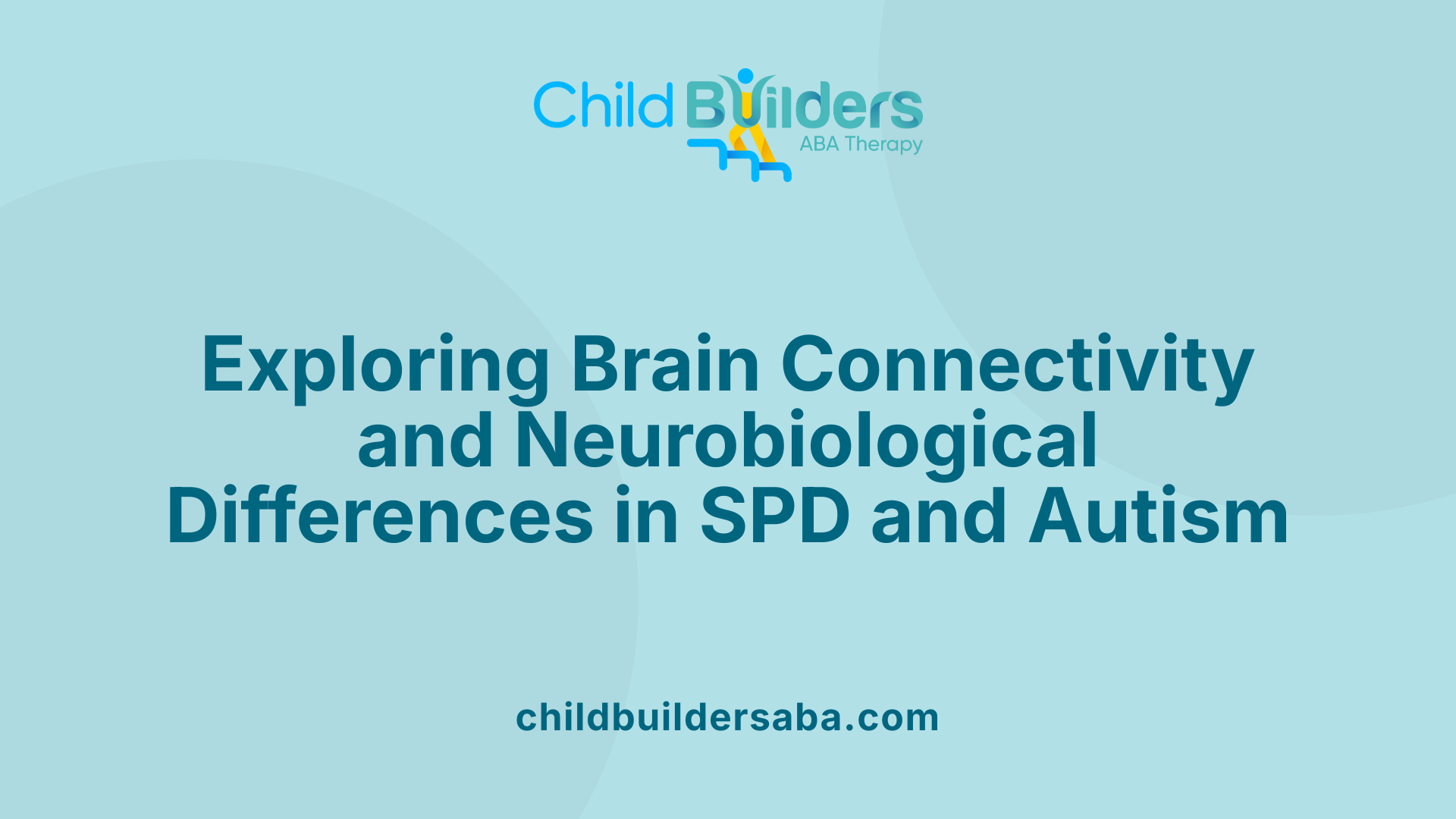
How can one differentiate sensory processing disorder from autism spectrum disorder?
Differentiating SPD from ASD involves examining their core features, behavioral patterns, and underlying neurobiology. SPD mainly affects how the brain receives and interprets sensory stimuli, resulting in hypersensitivity or hyposensitivity across senses like touch, sight, and sound. Children with SPD may react strongly to certain textures or sounds or seem unresponsive to sensory inputs, which can lead to challenges in daily routines. In contrast, autism spectrum disorder encompasses broader developmental issues, including significant difficulties in social communication, understanding social cues, and engaging in repetitive behaviors.
While over 80% of children with autism also show signs of SPD, the majority of children with SPD do not have autism. Autism involves persistent deficits in social interaction and communication, paired with specific behaviors like stimming. Neurobiological studies support these distinctions. For example, autism is linked to impaired connectivity in brain regions responsible for social and emotional processing, whereas SPD often involves altered brain connectivity specifically related to sensory pathways.
Clinical assessments differentiate these conditions by observing behaviors such as social engagement, communication skills, and sensory reactions. Employing thorough neurodevelopmental evaluations helps clarify whether sensory difficulties are part of autism or a separate sensory processing issue. Early diagnosis enables targeted therapies, with occupational therapy being effective for both, but with different focuses—sensory regulation strategies for SPD and comprehensive behavioral interventions for ASD.
What are the neurobiological differences between SPD and autism?
Neurobiological research indicates significant differences in brain structure and connectivity between SPD and autism. Advanced imaging techniques like MRI and diffusion tensor imaging (DTI) have uncovered distinctive patterns in neural pathways. Children with SPD exhibit atypical brain connectivity characterized by decreased white matter integrity in sensory-related brain regions. Interestingly, some studies show that children with SPD experience even greater disconnection in certain sensory pathways than children with autism.
In autism, the neurobiological picture is more widespread. Typical findings include disrupted connectivity in long-range brain circuits that are essential for integrating social, emotional, and sensory information. Individuals with autism often display under-connectivity in regions critical for social cognition, like the fusiform-amygdala pathways, and over-connectivity within localized brain areas. These disruptions contribute to core ASD symptoms, such as difficulty recognizing faces, emotional processing challenges, and repetitive behaviors.
Brain imaging studies have also revealed that autism involves impairments in the default mode network, a key neural network involved in social and self-referential processing. Such differences highlight that although SPD and ASD share some sensory features, their neurobiological underpinnings are distinct. This understanding emphasizes the importance of tailored diagnostic and intervention approaches for each condition.
Role of brain connectivity in differentiation
Brain connectivity patterns serve as vital markers in distinguishing SPD from autism. In children with SPD, reduced connectivity in sensory processing tracts indicates a primary dysfunction in how sensory information is transmitted and integrated. These neural disconnections contribute to difficulties in sensory modulation, affecting motor responses and emotional regulation.
Conversely, autism involves broader disruptions affecting multiple neural networks, especially those governing social behavior, language, and emotional understanding. Decreased connectivity in long-range connectivity between frontal and temporal lobes results in deficits in social cognition. Over-connectivity in local circuits within certain regions exacerbates repetitive behaviors.
Recent studies using DTI have shown that both SPD and ASD groups exhibit decreased connectivity in parieto-occipital tracts, important for basic sensory processing. However, the ASD group also displays impairments in tracts associated with higher-order social functions, such as the fusiform-amygdala pathways.
Understanding these connectivity differences helps clinicians develop more precise diagnosis and personalized treatment plans. For instance, interventions like sensory integration therapy (SIT) can effectively target neural pathways involved in sensory regulation in SPD, while therapies for ASD often aim to strengthen social and emotional brain circuits.
| Aspect | SPD Brain Features | Autism Brain Features | Additional Details |
|---|---|---|---|
| Connectivity | Atypical white matter in sensory regions; greater disconnection | Impaired long-range connectivity; over-connectivity locally | Influence sensory and social processing |
| Neural Pathways | Disrupted pathways in sensory processing tracts | Disrupted pathways in social-emotional and cognitive regions | Basis for behavioral symptoms |
| Brain Structures | Sensory processing regions, parieto-occipital tracts | Fusiform-amygdala, default mode network, social cognition regions | Targets for intervention |
Differences in brain structure and connectivity underscore the importance of tailored approaches. Recognizing these neurobiological variations informs clinicians about potential therapeutic directions, whether focusing on sensory modulation or social-emotional skills.
End of section.
Management and Therapeutic Approaches
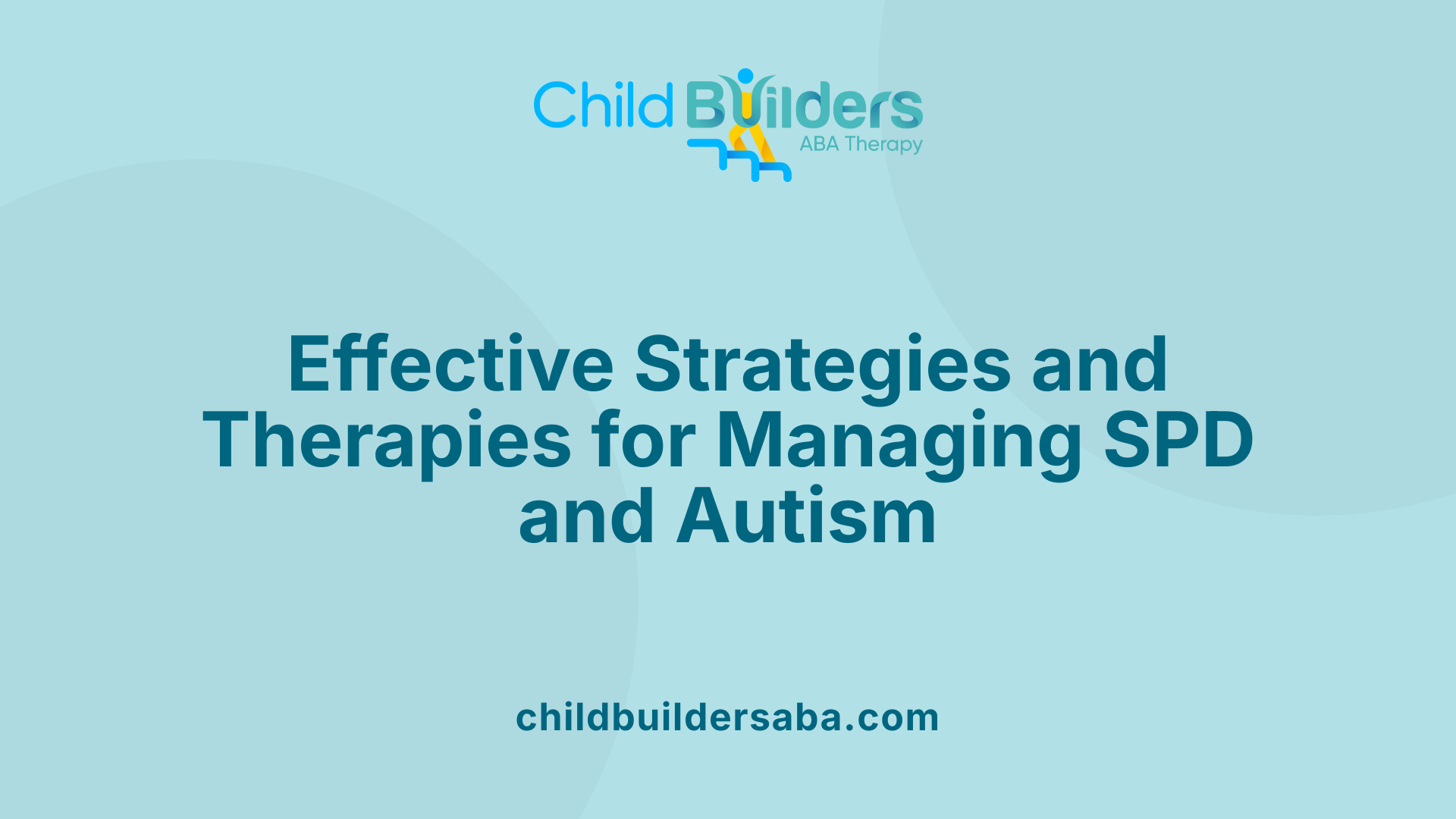
What treatment options or interventions are available for sensory processing disorder and autism?
Children diagnosed with autism spectrum disorder (ASD) and sensory processing disorder (SPD) often benefit from a variety of targeted treatment strategies, tailored to their individual needs. Although SPD itself is not an official diagnosis in the DSM-5, interventions designed to improve sensory regulation are widely used.
One prominent approach for SPD is sensory integration therapy (SIT). This therapy is typically delivered by trained occupational therapists who use specialized activities—such as movement exercises, deep pressure techniques, and sensory diets—to help children better process sensory information. The goal is to enhance their ability to regulate responses to sensory stimuli, thereby improving daily functioning.
In addition to sensory-specific interventions, behavioral and developmental therapies play a crucial role. Applied Behavior Analysis (ABA), discrete trial training (DTT), and pivotal response training are evidence-based methods that target behavioral challenges, promote social skills, and facilitate communication development.
Developmental therapies like speech, occupational, and physical therapy are often incorporated to support overall growth. These therapies help children acquire fundamental skills necessary for interaction and daily activities.
Educational and environmental adjustments are also vital. Programs such as TEACCH (Treatment and Education of Autistic and Communication related handicapped Children) focus on adapting learning spaces and teaching strategies to suit each child's unique learning style. Creating sensory-friendly environments—such as quiet rooms, weighted blankets, or visual supports—can reduce overstimulation and improve attention and comfort.
Social-relational interventions are designed to strengthen emotional connections and social understanding. Techniques like floor time and social skills groups encourage interaction with peers and caregivers, fostering emotional bonds and social competence.
While medications are not used to treat the core symptoms of ASD or SPD, they may be prescribed to manage concurrent issues such as anxiety, hyperactivity, or mood disturbances. It’s important to note that medication alone cannot address sensory processing difficulties.
In summary, a combination of therapies—ranging from sensory-based interventions, behavioral strategies, to environmental modifications—provides the most comprehensive support for individuals with SPD and autism. Early diagnosis and intervention are essential to achieving the best outcomes and enhancing quality of life.
Recent Advances and Future Directions in Research
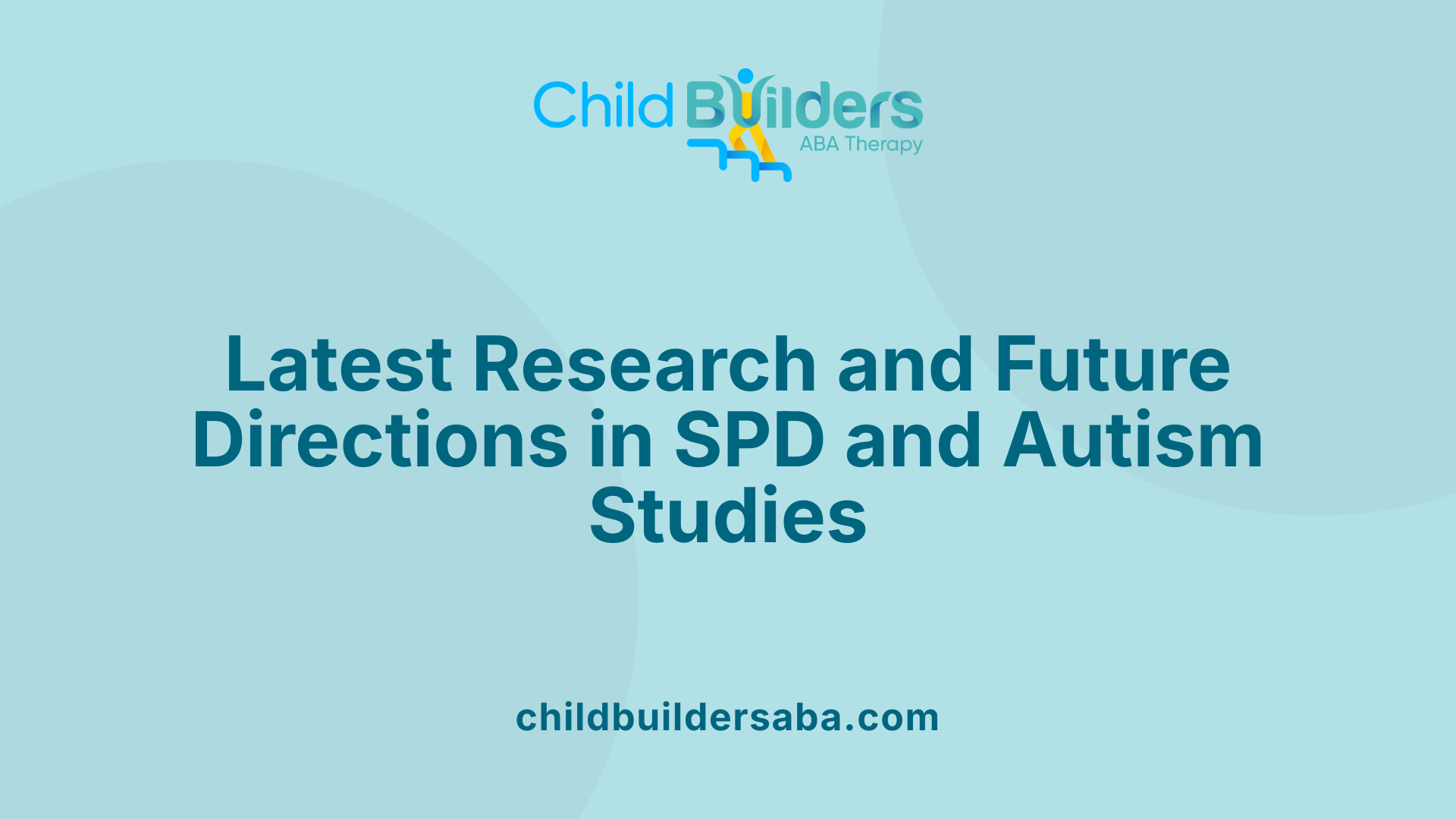
Are there recent research findings related to SPD and autism?
Recent scientific studies continue to shed light on the neurological bases of sensory processing disorder (SPD) and its connection with autism spectrum disorder (ASD). Researchers are exploring how the brain processes sensory information differently in these conditions, revealing both overlaps and distinctive features.
One significant area of investigation involves examining brain response patterns. Children with SPD often exhibit altered electrodermal activity, indicative of atypical physiological responses when processing sensory stimuli. These responses differ from those observed in children with autism, who tend to show broader disruptions in neural connectivity, particularly within social-emotional brain regions.
Advanced imaging techniques, such as diffusion tensor imaging (DTI), have been instrumental in identifying structural brain differences. Findings reveal that children with SPD display decreased white matter connectivity in specific sensory pathways, more pronounced than in neurotypical children but with unique patterns compared to children with autism.
Epidemiological data underscores the importance of this research. Approximately 16% of children aged 7 to 11 experience some form of SPD, while estimates suggest that 90-95% of autistic individuals show sensory processing challenges. This high prevalence highlights sensory issues as a common neurodevelopmental feature.
On the therapeutic front, emerging approaches are expanding treatment possibilities. The STAR (sensory, task, and environment readiness) model uses multidisciplinary strategies to promote sensory regulation and participation in daily activities. Neurostimulation techniques, including transcranial magnetic stimulation (TMS), are being explored to modulate neural circuits involved in sensory processing.
Innovative technologies like virtual reality (VR) are also being tested to create controlled sensory environments for therapy. These approaches can help reduce sensory overload and improve social engagement.
Ongoing neurobiological research aims to clarify the complex mechanisms that underlie sensory modulation. Studies investigating subgroups within SPD and ADHD are helping refine diagnosis and treatment, highlighting the importance of personalized interventions.
Furthermore, researchers are examining potential pharmacological therapies that target neurotransmitter imbalances implicated in sensory and cognitive dysregulation. While still in early stages, these studies offer hope for more targeted pharmacological options in the future.
In summary, recent research advances are enhancing our understanding of both SPD and autism, guiding innovative therapies, and moving us closer to more precise diagnosis and effective interventions for children affected by these challenging neurodevelopmental conditions.
Implications for Recognition, Support, and Education
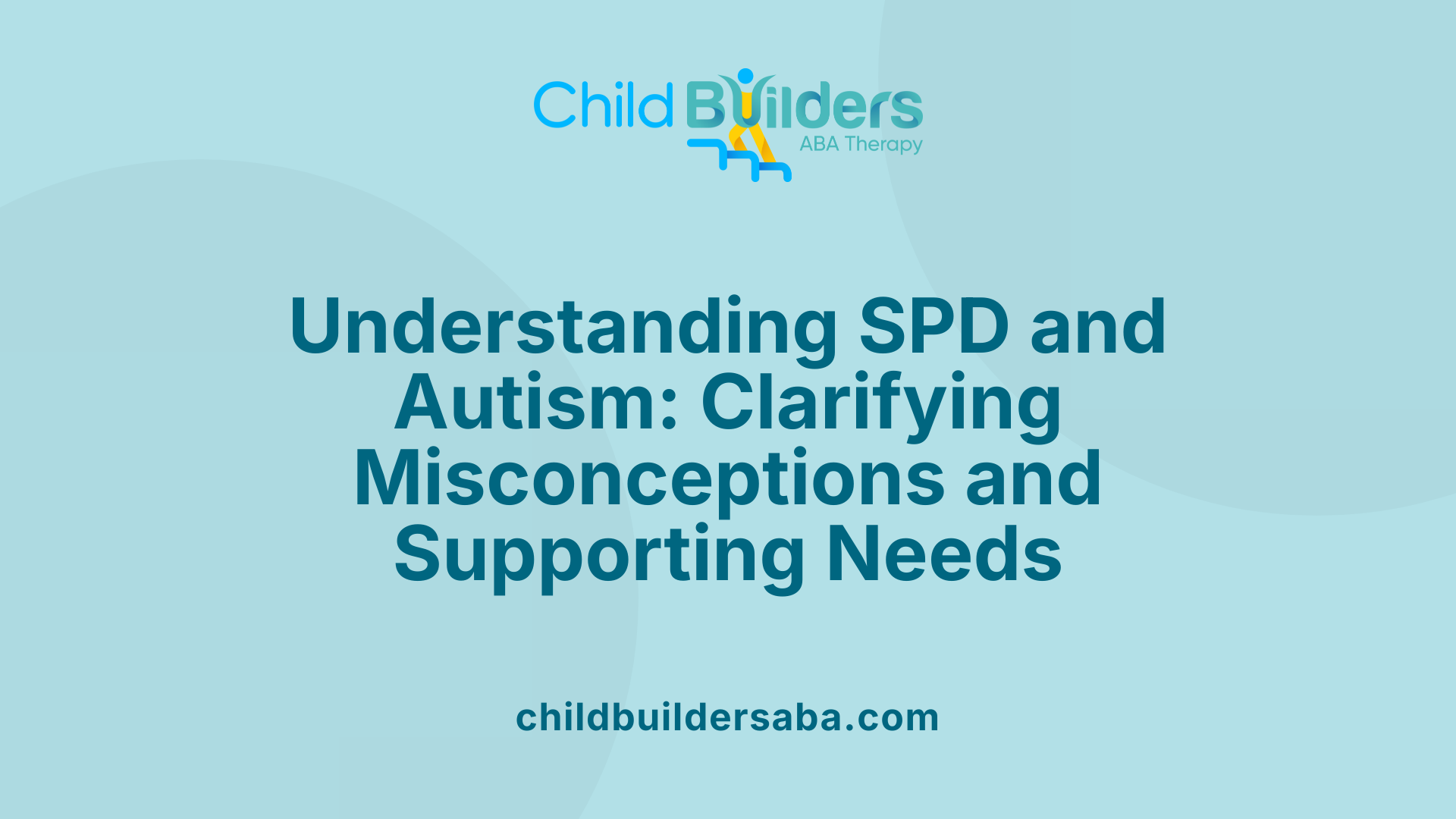
Clarifying misconceptions about SPD and autism
Sensory Processing Disorder (SPD) and autism spectrum disorder (ASD) are often misunderstood due to overlapping sensory behaviors. One prevalent misconception is that all children with sensory sensitivities necessarily have autism. In reality, most children diagnosed with SPD do not have autism, though sensory issues are common in both conditions. It is also important to clarify that SPD is not officially recognized as a standalone diagnosis in diagnostic manuals like DSM-5. Instead, it is seen as a neurodevelopmental symptom complex that can occur with or without other conditions.
Many confuse hyper- and hypo-responsiveness across these disorders, disregarding their distinct social, behavioral, and communicative features. Autism is characterized by persistent challenges in social interaction, communication, and repetitive behaviors, along with sensory processing differences.
Raising awareness about these differences helps reduce stigma and promotes better understanding. Recognizing that SPD is a separate condition, often comorbid with autism, facilitates targeted support strategies. It also emphasizes the importance of early diagnosis and intervention, which can significantly improve outcomes. Clear information helps educators, caregivers, and healthcare professionals develop appropriate accommodations and supportive environments tailored to individual needs.
What are effective support and educational strategies for individuals with SPD and autism?
Supporting individuals with SPD and autism requires personalized approaches that address diverse sensory and developmental profiles. Educational settings benefit greatly from sensory-friendly adaptations, such as
- Sensory-friendly classrooms with adjustable lighting and minimal noise
- Use of noise-canceling headphones or calming corner areas for sensory breaks
- Visual schedules and organizers to help with routines and transitions
Support strategies also include behavioral interventions and therapies tailored to sensory needs. Sensory diets involve structured activities designed to provide or reduce sensory input, helping individuals regulate their responses.
Occupational therapy, particularly sensory integration therapy, plays a central role in helping children process sensory information more adaptively. Social skills groups, social stories, and peer-mediated programs assist children in developing communication abilities and understanding social cues.
Providing education to families and caregivers about sensory sensitivities, potential behavioral triggers, and environmental modifications is crucial. This knowledge empowers caregivers to create supportive routines at home and develop consistent strategies.
In addition, fostering an inclusive environment that recognizes and values neurological differences helps individuals feel accepted and confident. This includes training staff and peers to understand sensory and social challenges.
Through such comprehensive, tailored support systems—combining environmental adjustments, therapeutic interventions, and educational accommodations—children and adults with SPD and autism can experience improved quality of life, greater independence, and fuller participation in social and academic activities.
| Aspect | Support Strategy | Description |
|---|---|---|
| Educational | Sensory-friendly classroom | Adjusted lighting, reduced noise, calming areas |
| Therapy | Sensory integration therapy | Activities tailored to improve sensory processing |
| Behavioral | Sensory diets | Specific activities to regulate sensory input |
| Social | Peer-mediated programs | Facilitated social interactions |
| Family Support | Caregiver education | Training on sensory sensitivities and triggers |
This strategic approach underscores the importance of understanding individual sensory profiles and implementing personalized solutions to support development and social integration.
Summarizing Key Differences and Moving Forward
While Sensory Processing Disorder and Autism Spectrum Disorder frequently overlap in sensory sensitivities, they are fundamentally different in their core characteristics, neurobiological mechanisms, and treatment approaches. Understanding these distinctions is crucial for accurate diagnosis and effective intervention. Advances in neuroimaging and research continue to shed light on the unique brain pathways involved, opening new avenues for personalized therapies. Awareness and education are vital to dispel misconceptions, promote early detection, and provide appropriate support. Whether occurring independently or together, addressing sensory challenges with evidence-based strategies enhances the quality of life for affected individuals, empowering them to navigate daily environments more comfortably and confidently.
References
- Sensory Processing Disorder vs. Autism: What's the Difference?
- Sensory processing disorder vs. autism: Differences explained
- It's Not Autism, It's Sensory Processing Disorder - Psychology Today
- Sensory Processing Differences in Individuals With Autism Spectrum ...
- Sensory Processing Disorder vs Autism: What's the Difference? - AT4K
- Sensory processing disorder (SPD) - Autism Speaks
- Sensory Processing Issues Explained - Child Mind Institute



.jpg)

































































































